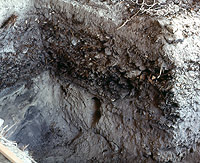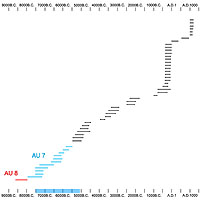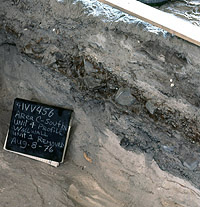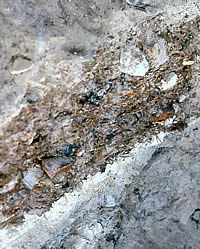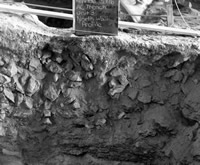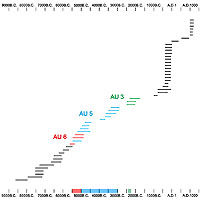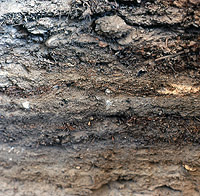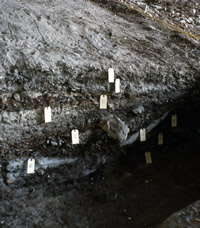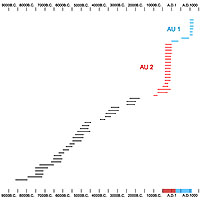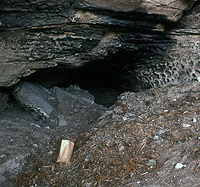Analysis Units
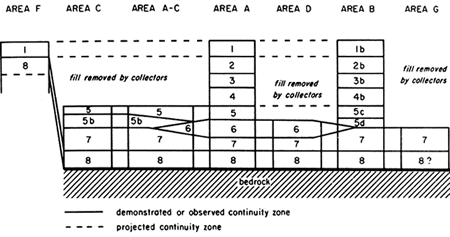
As explained in the stratigraphy section, when the Texas A&M archeologists began their analyses they realized that they needed to simplify the stratigraphy for analysis and meaningful comparison between excavation areas. To do this, lead investigator Harry Shafer collapsed the Hind Cave lenses into eight analysis units, which are functionally equivalent to the zones used during the 1960s excavations at dry rockshelters within Amistad reservoir. These analysis units are groupings of lenses that seemed to form depositional zones seen in various excavation units across the shelter. The Hinds Cave analysis units (abbreviated AU) were numbered from top to bottom. Here we’ll discuss them from the bottom up, in the order these deposits formed through time.
Analysis Unit 8
This unit (AU 8) comprised the deepest deposits in Hinds Cave, which consisted
mainly of white limestone dust and limestone spalls from the roof and walls
of the shelter. In the upper part of AU 8, occasional charcoal lenses
were encountered as well as a sparse and uncertain amount of cultural materials. This
unit formed a broad zone encountered at the base of most excavation
areas. AU 8 thickened from the back of the cave toward the front
and it is likely that the deepest and thickest part of this zone was never
reached. In Area A the bedrock floor of the shelter was at least 2.3
m below the surface.
The only radiocarbon assay from the AU 8 deposits was run on charcoal obtained
from the upper part of the zone in the north wall of the A-C Trench. The resulting
calibrated date has a mid-point of 8290 B.C. No projectile points were
found in the zone, but the assay and identification of three Pleistocene horse
bones from probable AU 8 contexts suggests that the lowest depositional unit
(AU 8) at Hinds Cave formed during the Late Pleistocene prior to 10,000 years ago. This age estimate is consistent with the earliest well-documented projectile points from Hinds Cave: two Golondrina points. Unfortunately, these were not found in definitive AU 8 contexts.
In 1986, archeologists Lee Bement and Solveig Turpin published a short article
describing an Early Paleoindian Folsom point that an artifact collector claimed
to have found at Hinds Cave in the 1960s. Michael Collins (1996) later showed
this claim to be false—the exact same point had been photographed in 1949 and was then reported to have been collected in Blanco County in the mid-1930s. It is likely that the later collector had indeed dug in Hinds Cave and may have found early material, but, if so, he was confused about what he found where. This tale illustrates the value of proper documentation—memories fade and unlabeled collections become mixed.
It must be acknowledged that the deeper deposits at Hinds Cave were primarily
naturally-formed layers of limestone dust and roof spall and they were reached
only in relatively small excavations, usually at the end of field seasons. For
these reasons, the layering was not always clear and it seems likely that
the excavators were often not able to separate AU 8 from the overlying AU 7
deposits. The earlier, Late Pleistocene-age, naturally-formed deposits
were almost certainly dug into by the earliest groups making significant
use of the site roughly 10,000-11,000 years ago, thus creating mixed-age deposits.
Because of these factors, some of the initial assignments of excavation lenses and levels to AU 8 were probably in error, leading various analysts to incorrectly attribute perishable remains including basketry and knotted fiber as well as several coprolites and a variety of animal bones to the AU 8 deposits. It seems more likely that most of these organic materials probably came from mixed-age lower deposits and most probably date to after 8,000 B.C. No known plant remains (except the dated charcoal) were recovered from any excavation context that can be confidently assigned to AU 8. Future researchers will need to revaluate the dating of the site’s deepest and earliest deposits and contexts.
Analysis Unit 7
This unit was composed of ash and fiber lenses containing numerous artifacts and represents the first major occupational zone in Hinds Cave. AU 7 deposits were encountered in all excavation areas. Perishable materials were generally well preserved and include basketry and netting, plant remains, coprolites, and animal bones. At least one and possibly two prickly pear pad floors were found as well as latrine layers and other features. The AU 7 deposits formed between about 5600 and 7500 B.C. at the end of the Late Paleoindian period and during the first half of the long Early Archaic period.
The dating of this unit is well established by 12 radiocarbon assays, one of which has been rejected as being implausibly old. The erroneous date of 12,060 BC (calibrated midpoint; reported date: 11550 +/- 190 B.P.) was on a sample of charcoal and prickly pear pad from one of the prickly pear pad floors. The other 11 assays from A.U. 7 contexts range from 5660 to 7540 B.C. (calibrated midpoints).
Preservation conditions were generally excellent resulting in the recovery of many perishable artifacts, coprolites, plant remains, and animal bones. Some 49 projectile points are assigned to AU 7 including two Late Paleoindian types, a Golondrina and an untyped lanceolate point, and 44 dart points (1 Almagre, 1 Langtry, 2 Pandale, 7 Val Verde points, 14 Baker points, and 19 untyped dart points)
Analysis Unit 6
This unit was a buried burned rock midden, a concentrated layer of fragmented burned rocks (mostly fist-sized or smaller) with few perishable remains that extended across Areas A and D and into Areas B and A-C. The midden was approximately 50 cm (20 inches) thick; its horizontal dimensions are unclear, but it appears to have been some 5 meters across.
Today we realize that this midden layer is composed of debris that was generated by the use of heated cooking stones to bake plants. The center of cooking activity was probably a roasting or earth oven pit, similar to the “sotol pit” recognized in the upper deposits. Although no roasting pits were recognized during the excavations, a cluster of large burned rocks was encountered in excavation unit D-2 and depicted in the south wall profile of Area D. Today we know that large, intact cooking stones are typically found with central pits whereas most of the surrounding debris consists of smaller, heavily fractured rocks cleaned out of the cooking pit.
The AU 6 midden deposit is dated by three radiocarbon assays with calibrated midpoints ranging from about 5000-5500 B.C. Eleven dart points were assigned to AU 6 including 3 Early Archaic types (2 Early Barbed and one Corner Notched), 2 Middle Archaic types (2 Langtry), a Late Archaic Ensor point (probably misclassified), and 5 untyped dart points. No explanation is offered for the apparent mixing of dart points representing various time periods, but the radiocarbon dates are consistent with one another and the overall dating of the Hinds deposits.
On the basis of the multiple overlapping radiocarbon dates between about 5300-5000 B.C., the AU 6 midden appears to have been accumulating at the same time the earliest AU 5 deposits formed.
Analysis Unit 5
This unit is one of the most complex and important Hinds deposit sets. It consisted of numerous lenses of ash, fiber, coprolites, and burned rock that, collectively, extended across all excavation areas (except the alcove). AU 5 was subdivided into four subunits in an attempt to account for depositional differences observed across the excavations. In the main excavation areas (C, A, A-C, and B) the AU 5 deposits were partially mixed with the overlying and underlying deposits. Really, this statement is true of many Hinds deposits – some mixing occurred among major groupings as a consequence of prehistoric behaviors (such as pit digging) and the excavation methods. This is simply a fact of life in the dry shelters of the Lower Pecos.
AU 5a was noted in Areas A and A-C and had multiple lenses of the kinds mentioned above. AU 5b was a thick lens of coprolites, fiber, and burned rock that occurred immediately below AU 5a in Area A and the west end of the A-C Trench. AU 5c is the undifferentiated AU 5 deposit encountered in Area B, where it overlay unit AU 5d. AU 5d was excavated as Lens 13, a thick coprolite layer representing a latrine with some scattered burned rocks mixed in. Lens 13 is one of the most important deposits sampled at Hinds Cave because it was the source of the first and largest coprolite study by Williams-Dean.
The AU 5 deposits formed over a 2300-year span between about 3000 and 5300 B.C., during the latter Early Archaic period and the early part of the Middle Archaic period. The dating of AU 5 is well established by 9 radiocarbon assays (calibrated mid-points 3120 – 4845 B.C.). In addition, 41 dart points were assigned to unmixed AU 5 deposits, including 9 Pandale, 7 Langtry, 5 Val Verde, 3 assorted Middle Archaic points, and 17 untyped points. All of the typed points are thought to date to the Middle Archaic. Perishable materials were well preserved and abundant including basketry, matting, sandals, plant remains, and animal bones.
The earliest dates from AU 5 overlap with two of the three dates from the burned rock midden deposit designated AU 6, suggesting that the two sets of deposits are partially contemporaneous, between roughly 5300-5000 B.C.
Analysis Unit 4
This unit (AU 4) was only present in Area A and consisted of thin, superimposed ash and fiber layers. This unit was thought to be correlated with AU 4b, a thick fiber deposit containing hundreds of live oak leaves recognized only in Area B. The fiber layer (AU 4b) was charred on its northern and eastern margins where it was bordered by ash and burned rock. The oak leaves are thought to represent a purposeful floor covering brought in to hold down the ever-present dust.
No radiocarbon assays were run on samples from AU 4. All four of the seven dart points definitely attributed to AU 4 that could be identified are Middle Archaic types (3 Val Verde and 1 Langtry). Based on radiocarbon dates from AU 5 and 3, AU 4 appears to have formed in the 600 year span between 3000 and 2400 B.C.
Analysis Unit 3
This unit consisted of a series of ash and fiber lenses encountered in Areas A and B. Those lenses recognized in Area B were designated as AU 3b. Three radiocarbon assays from AU 3 samples overlap between 2400-2300 B.C. Only four dart points from unmixed AU 3 deposits could be assigned to a type (two Langtry and two Val Verde points). The radiocarbon age and the dart points from AU 3 fall within the later Middle Archaic period.
Analysis Unit 2
This unit consisted of ash and fiber lenses similar to those of AU 3. It is part of the badly disturbed upper deposits and intact portions of AU 2 were seen only in Areas A and B. The single radiocarbon assay definitively assigned to AU 2 has a calibrated midpoint of 335 B.C., a date falling in the later part of the Late Archaic. The calibrated 2-sigma range of this date overlaps strongly with 14 recently reported assays obtained from an infant bundle burial said to have been found by a collector at Hinds Cave (Steelman et al. 2004). The veracity of this claim is hard to evaluate, especially given the false claim mentioned above in regard to the Folsom point alleged to have come from Hinds Cave. The dating of the bundle burial is consistent with the known and inferred age of the upper fiber deposits at Hinds Cave.
Analysis Unit 1
The uppermost layer of Hinds Cave consisted of compacted fiber lenses and burned rock, most of which had been badly disturbed by artifact collectors and livestock (sheep and goats). Portions of seemingly intact fiber deposits were encountered in Areas F, A, and B. The Area F excavations encountered a layer of burned rock and cut sotol leaf bases described as a burned rock midden. About 3 m (10 feet) south of Area F, artifact collectors had exposed a distinct depression within a burned rock deposits. This was termed a “sotol pit”, a name commonly used to designate the central cooking or roasting pit of an earth oven facility used to bake sotol hearts. This feature was not excavated, but it seems clear that one or several earth oven facilities existed in late times at the north end of the shelter.
Seven of the eight radiocarbon dates assigned to AU 1 are those from two sticks said to be found by a collector in the 1950s near or with the bundle burial; whether or not the items actually came from Hinds Cave as reported is not known. Over 40 years elapsed between the time the collector is said to have removed the sticks and burial from Hinds Cave and the time archeologists examined and dated the materials.
A single radiocarbon date from a definitive AU 1 context in Area F has a calibrated midpoint of A.D. 205, suggesting that the uppermost layer of Hinds Shelter formed in the latter part of the Late Archaic period. Three Late Archaic dart points (2 Ensor and 1 Frio) were assigned to AU 1 as were two Val Verde points and 7 untyped points. The wood sticks that found near the bundle burial purported to have been found at Hinds Cave dates even later the sole AU 1 date. It is likely that the uppermost deposits at Hinds Cave included some materials dating to the Late Prehistoric period; the only definitive Late Prehistoric artifacts recovered during the Texas A&M investigations were three arrow points found in the upper deposits in Area F.
